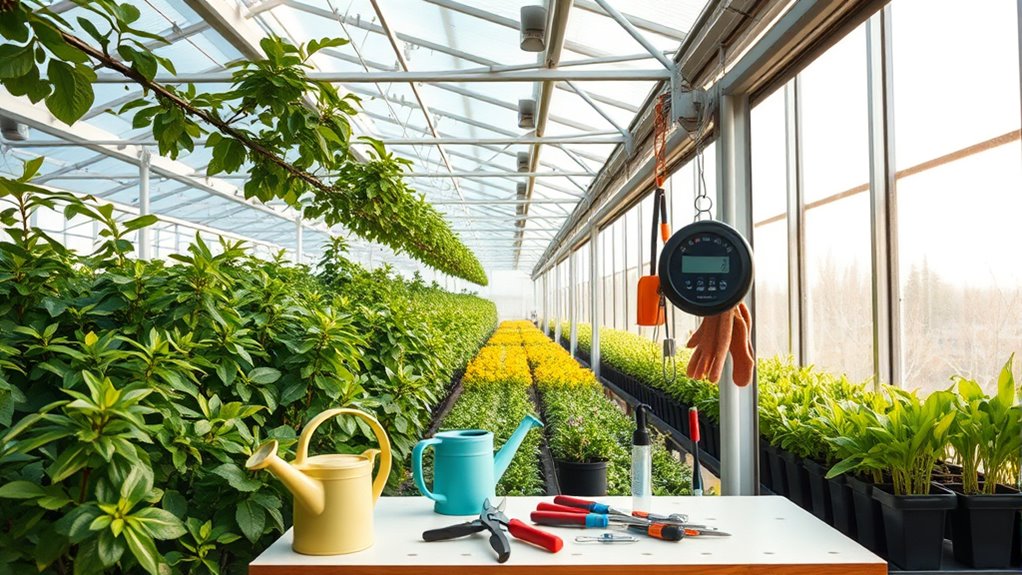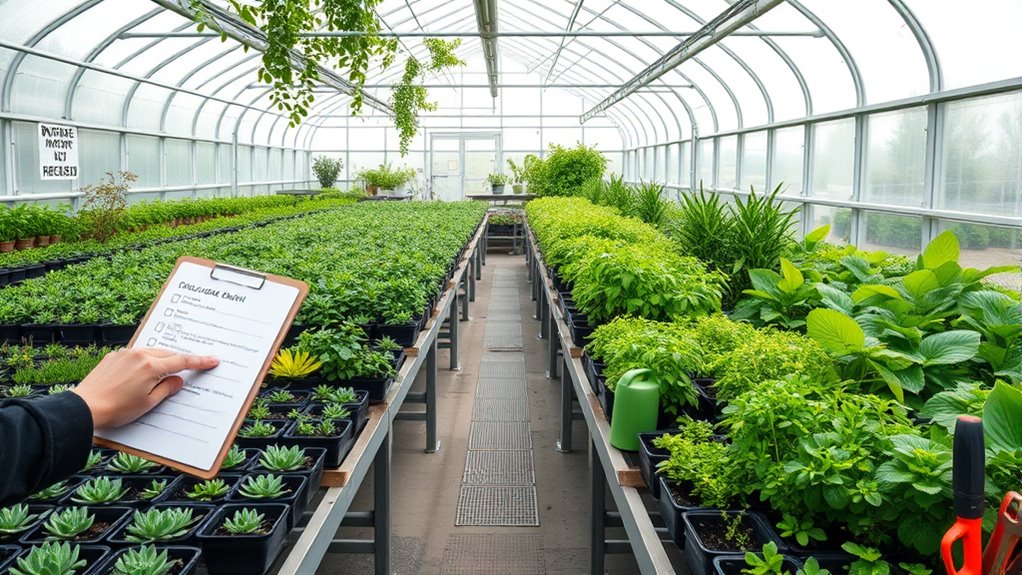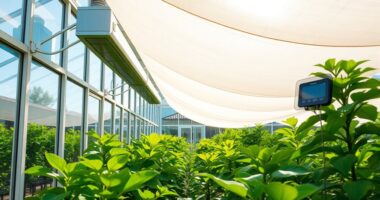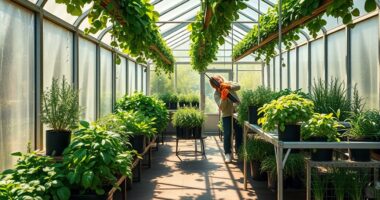To keep your greenhouse thriving, regularly check and maintain your ventilation system to guarantee proper airflow and temperature control. Keep pests at bay by inspecting for signs of infestations, removing debris, and using organic methods or beneficial insects. Maintain cleanliness by disinfecting tools, benches, and floors to prevent disease spread. Monitoring plant health daily helps catch issues early. Once you follow these steps, you’ll ensure a healthy, productive environment—more tips await if you continue exploring.
Key Takeaways
- Regularly inspect and clean ventilation systems to ensure proper airflow and prevent mold or pest issues.
- Conduct routine pest and disease inspections, and implement organic or chemical treatments as needed.
- Maintain cleanliness by disinfecting tools, benches, and floors to reduce pest and pathogen risks.
- Monitor environmental conditions daily, recording issues and responding promptly to early signs of problems.
- Incorporate AI automation and perform preventive maintenance to optimize climate control and system performance.

Maintaining a healthy greenhouse requires regular attention and a clear maintenance routine. One of the most essential aspects of this routine is ensuring your ventilation systems are functioning properly. Proper ventilation not only regulates temperature and humidity but also prevents the buildup of stale air that can lead to plant diseases. Regularly check your vents, fans, and exhaust systems to make sure they’re clean and working efficiently. If you notice any blockages or signs of wear, address them immediately. Good airflow helps keep pests at bay and reduces the risk of mold and mildew, creating a healthier environment for your plants. Incorporating AI automation into your greenhouse management can further optimize climate control and monitoring processes.
Pest control is another fundamental component of greenhouse maintenance. Pests can quickly become a serious problem if left unchecked, damaging your plants and spreading diseases. Develop a pest management plan that includes routine inspections—look for signs like chewed leaves, webbing, or discolored spots. Keep your greenhouse clean by removing dead leaves and plant debris, which serve as hiding spots for pests. Use physical barriers such as insect screens on vents and doors to prevent pests from entering. Introducing beneficial insects, like ladybugs or predatory mites, can also help keep pest populations under control naturally. When necessary, apply appropriate organic or chemical treatments, but always follow manufacturer instructions to avoid harming your plants or beneficial insects.
Maintaining a tidy environment is essential for pest control, so make it a habit to clean and disinfect tools, benches, and floors regularly. This minimizes the chance of pests and diseases spreading from one plant to another. Monitoring your plants daily helps you catch problems early, making pest control more manageable and less invasive. Remember, prevention is better than cure, so don’t wait until you see visible damage before acting. Regularly inspecting your greenhouse’s ventilation systems and addressing issues promptly ensures a steady airflow, which discourages pests and fungal growth. Keeping these systems in top shape also improves overall plant health, boosting growth and productivity.
Frequently Asked Questions
How Often Should I Replace Greenhouse Filters?
You should replace greenhouse filters regularly to guarantee ideal airflow and prevent contaminants. Generally, check your filter monthly and replace it every 3 to 6 months, depending on your greenhouse’s conditions and the filter type. Regular filter replacement is a key part of greenhouse cleaning, helping maintain a healthy environment for your plants. Keep an eye on filter performance and replace it promptly when you notice reduced airflow or dirt buildup.
What Are Signs of Ventilation System Failure?
Did you know that poor ventilation can reduce airflow efficiency by up to 50%? Signs of ventilation system failure include inconsistent temperature control, lingering humidity, and musty odors. You might also notice decreased airflow, unusual noises, or equipment malfunctions. For effective ventilation troubleshooting, check for blocked vents, broken fans, or dirty filters. Addressing these issues promptly keeps your greenhouse healthy and guarantees ideal growth conditions.
How Can I Prevent Mold Growth in My Greenhouse?
To prevent mold growth in your greenhouse, you need to focus on humidity control and water management. Keep humidity levels balanced, avoiding excess moisture that encourages mold. Use proper watering techniques, like watering at the base and avoiding overhead sprinklers, to reduce humidity. Make certain of good air circulation and regularly clean surfaces to prevent mold spores from settling. Proper ventilation also helps maintain ideal conditions, minimizing mold risks and promoting healthy plant growth.
What Are the Best Practices for Pest Prevention?
Oh, sure, just hope pests magically vanish—who needs prevention anyway? Instead, you should use biological controls and plant pest-resistant varieties. These methods act like an immune system for your greenhouse, keeping pests at bay naturally. Regularly inspect plants, maintain cleanliness, and encourage beneficial insects. With these smart practices, you’ll outsmart pests and keep your greenhouse thriving without relying on harsh chemicals.
How Do I Calibrate Greenhouse Temperature Sensors?
To calibrate your greenhouse temperature sensors, first check their accuracy against a reliable thermometer. Use calibration procedures like adjusting the sensor or applying a correction factor if needed. Make certain your sensors are clean and positioned correctly, away from direct sunlight or drafts. Regular calibration maintains sensor accuracy, helping you control temperature precisely for ideal plant growth. Perform this process periodically to prevent drift and ensure consistent readings.
Conclusion
By following this friendly, focused greenhouse maintenance checklist, you’ll foster flawless foliage and fabulous flowers. Regular reviews keep pests, pests, and problems at bay, ensuring your greenhouse grows gracefully. Stay steadfast with scheduled inspections, swift with safety checks, and meticulous with maintenance tasks. With consistent care and commitment, your greenhouse will flourish into a flourishing, fabulous haven. So, stay vigilant, stay vigilant, and watch your wondrous greenhouse wildly thrive!









